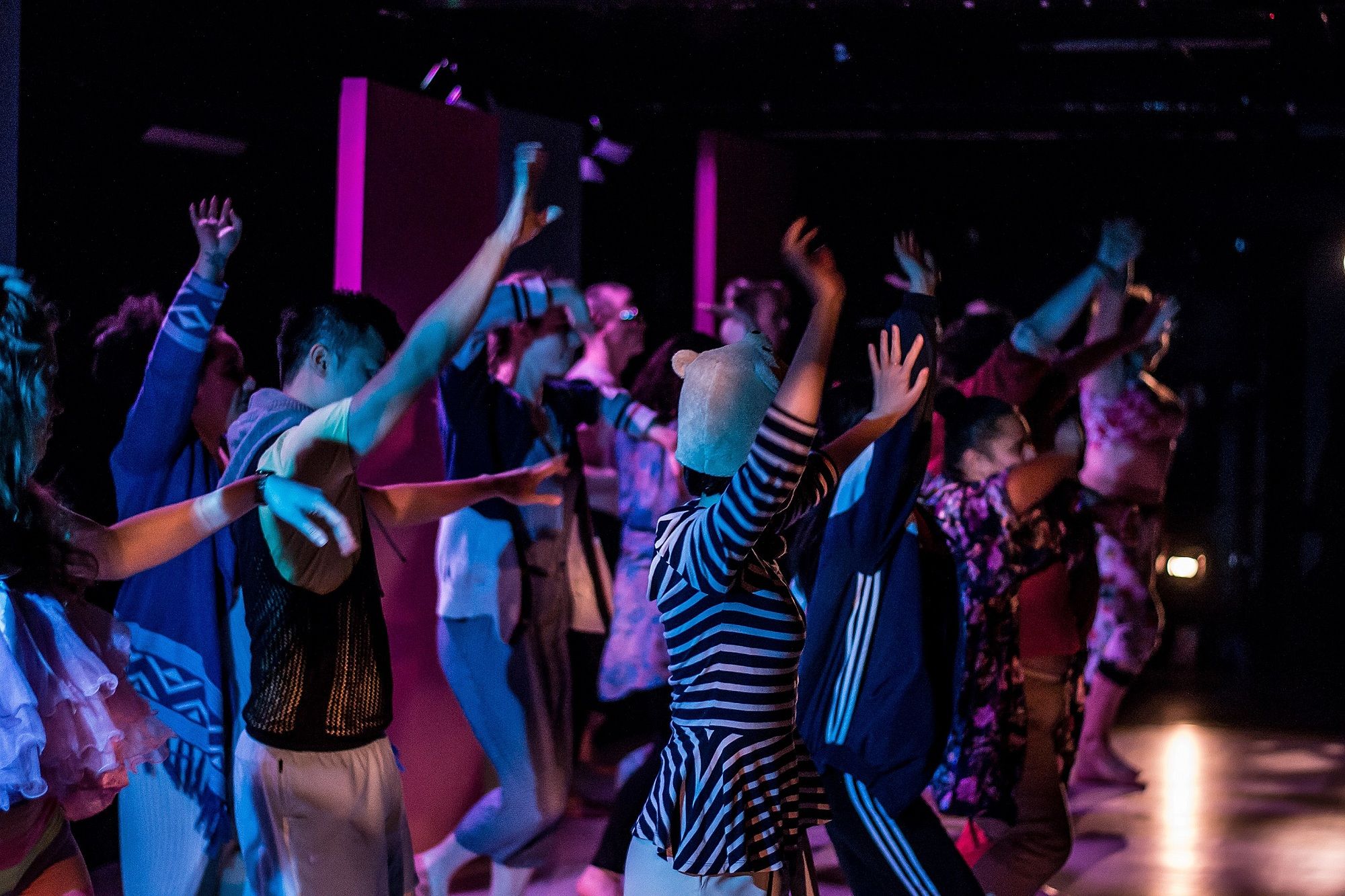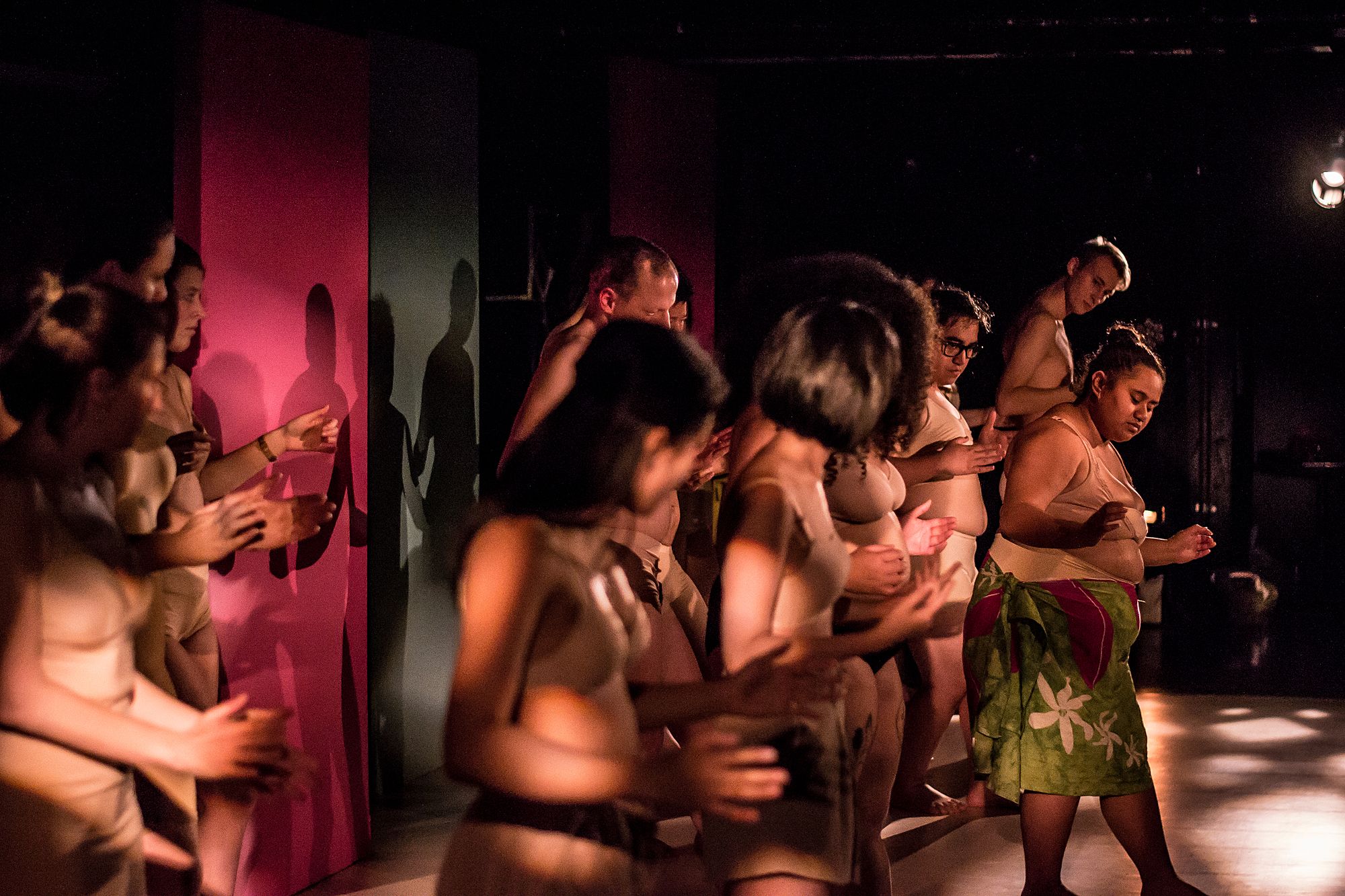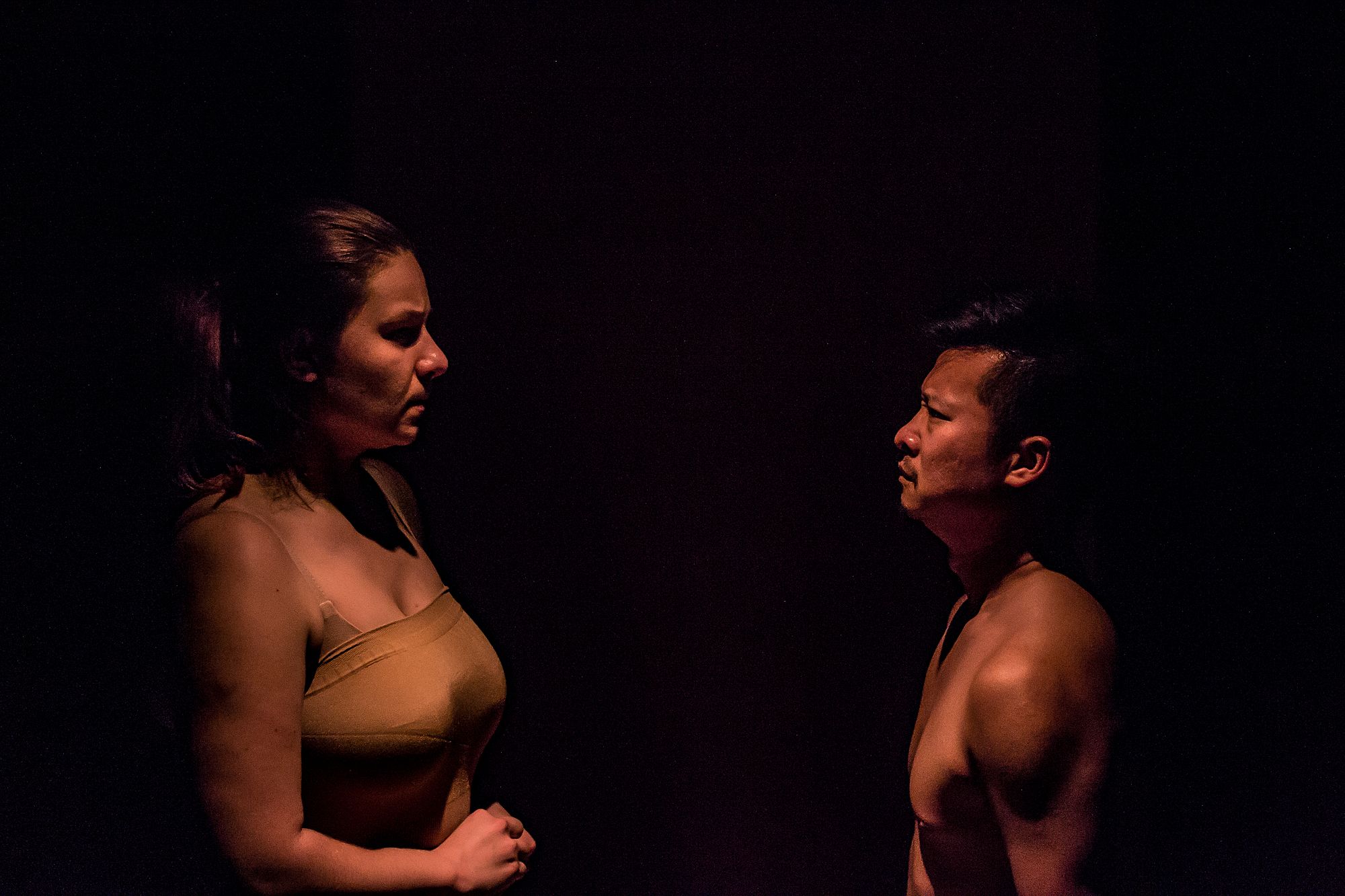Body Talk: A Review Of Fleshies
New Volumes critic Waveney Russ reviews the new play from Basement Theatre's Producer In Residence Alice Kirker, a smorgasbord of scenes and stories about bodies, brains and the pressure society puts them under.
New Volumes critic Waveney Russ reviews the new play from Basement Theatre's Producer In Residence Alice Kirker, a smorgasbord of scenes and stories about bodies, brains and the pressure society puts them under.
Hands are my favourite part of the human body. They’re the first fleshy extension of myself that enters any new situation. Holding the pen that signs a contract for a job, running through the hair of a lover, interlaced in a family member’s own fleshy extension for the last time: hands are one of our greatest tools for forging connections with the people around us. Celine Dam agrees: she notes all this in the opening scenes of Fleshies at Basement Theatre, in a thoughtful monologue on the importance of our hands.
It’s important to have at least one favourite body part, because loving our bodies in the era of social media curation is really fucking difficult. Our collected algorithms throw up static endorsements of a white, toned, mono-gendered, able-bodied ideal, an ideal that has yet to catch on to the beauty in diversity. In reality, our bodies grow and recede in strange ways. They produce curious noises and odours, and they’re etched with colourful marks that distinguish our fleshy casing from our next-door neighbours. Comparison is the thief of joy, and when it comes to our bodies, comparison is programmed deep in our reptilian brain. It can make it impossible to be comfortable with our identities.
That’s where the fifteen-strong cast of Fleshies steps in. Fleshies is an hour-long celebration of underrepresented bodies presented by The Oddballs Theatre Company (producers Alice Kirker and Kate Longbottom). Sick of seeing unconventional body types take the role of secondary characters in theatre productions, the team behind Fleshies wants to short-circuit the time it takes for you to see these bodies on stage. The show celebrates Asian, Pacific Island, Māori, gay, lesbian, gender fluid, old, fat, every different size and type of body.
All the Fleshies wear comfortable clothing or plain nude underwear, celebrating their bodies as they exist, without embellishment – visible and proud. Directed by Bryony Skillington and Grace Augustine, they play out a series of sketches, monologues and dances in these costumes. Sketches range from ‘tutorials’ on how to be a man, woman or person to a scene in the human brain, the brain firing off anxious concerns about their body while they’re preparing for a night out. These sketches are interspersed with monologues about insecurity and empowerment, each an entry point into the personal experiences of the cast member talking. These monologues are delivered with empathy, introspection, and occasional gut-wrenching hurt.
These sketches are also punctuated with dance numbers, drawing on styles from voguing to traditional siva Sāmoa. All the while, cast members move onto the empty stage from behind pink and green screens; they swell in numbers and then recede from scene to scene.
Fleshies says it’s not enough to just talk about different bodies being beautiful. We need to talk about different bodies being able to relax.
Fleshies doesn’t just interrogate the most familiar concepts of body positivity, such as fat acceptance and unrealistic beauty standards. It takes an expanded approach, interrogating the ways in which our physical form influences how we construct our identities. In the human brain sequence, depicting the chaotic anxiety of the choices we make about our body on a night out – from what to wear to who we go home with – Quinn He performs a monologue in Mandarin in her native tongue. She expresses the aspirations of immigrant and Asian diaspora who live in white communities that uphold monocultural beauty standards; it would have been heartening to hear a Māori or Pacific perspective on beauty standard exclusion here as well.
In another scene, a series of performers express their disdain for the spinal cord’s influence on the brain. Todd Waters draws on connections between the human spine and the titan Atlas, who bore the weight of the world on his shoulders, while others present a more conceptual approach to addressing physical insecurities, one focussed on the brain as a primary source of antagonism, anxiety and shame. They gesture to the long-term psychological effects of body-shaming – the depression, anxiety, eating disorders and body dysmorphia that can come with it.
These monologues, and other parts like them, emphasise that body positivity isn’t just about affirming all bodies and their presence on social media platforms. Body positivity is also about the ways we perform our identity; it’s a response to the performances we’re expected to carry out in public, and it requires the elimination of those performances that don’t have a positive influence our own personal development. By detailing the crucial brain-to-body connection that is often forgotten about in mainstream dialogue, Fleshies contributes a fresh perspective to this discourse. It says that it’s not enough to just talk about different bodies being beautiful. We need to talk about different bodies being able to relax.
But while Fleshies presents some new ideas, its stories are often brief and lacking the level of personal detail required for us to connect in a more resonant way. Most of the anecdotes are repackaging tenets of the Third Wave of the body positivity movement for an unfamiliar audience: beauty is a social construct, that construct has a negative effect on people’s confidence and self-worth, etc. These core observations are for the most part packaged accessibly, but other moments fall short, lacking the educational value that you’d expect from an introductory text. For example, in a scene in which cast members deliver short monologues on the insecurities they face, one cast member says she has been labelled in the past as “too blonde, and offensively skinny.” Fleshies tenaciously tries to include the entire spectrum of ways people feel oppressed in their bodies, but it could push beyond the surface of the observation; at present, moments like these take up too much space at the expense of other narratives. Moments like these could stand aside altogether, allowing room for more narratives from people of colour and those non-conforming to gender and sexuality norms. It’s not that Fleshies doesn’t have those, nor is it lacking in complexity, but it isn’t as rich or confrontational as it could be when it comes to addressing the harms of body shaming.
Fleshies is still a strong 101-type production that uses comedy and storytelling to bridge the gap between discourse-conscious young people and the older generation who don’t really get it when their teen comes home talking about the kyriarchy. It accessibly delivers the basics of a movement revolving around the concept that all body types can and should be celebrated. It’s a welcome side-effect of the show’s main agitation: a revolution of radical self-love.
With a different set of cast members, Fleshies could have been a cringy story of self-acceptance and self-love, like your parents reluctantly telling you how sex works or a cool edu-show coming to your school to tell you how drugs are bad. However, Skillington and Augustine, and the fifteen Fleshies, understand the importance of their story. They maintain a delicate balance between engaging with the discourse surrounding a prominent social movement, depicting the lived experiences of marginalised bodies with respect, and presenting the universal realities of owning a human body. Making bodies like our own visible on screens and stages makes all the difference when it comes to accepting the parts that aren’t so palatable. Although the show may not present new ideas to a generation that has lived through the body positivity movement, Fleshies has more than enough to say to those who are still at the early stages of their education.
Correction: (27/06/19): An earlier version of this review incorrectly attributed several parts of a "monologue... about the spinal cord's influence on the brain" to performer Aun Sukijjakhamin. This scene involves a number of performers including Sukijjakhamin, but certain elements of the scene were delivered by other performers. The scene description has been updated to correctly reflect the performers involved.
Fleshies runs from June 18 to 29 at Basement Theatre. Tickets available here.
Header image credit: George Wallace.
This piece is presented as part of our New Volumes critical writing partnership with Basement Theatre. Basement Theatre covers the costs of paying our writers while we retain all editorial control. You can read more about the programme here.




